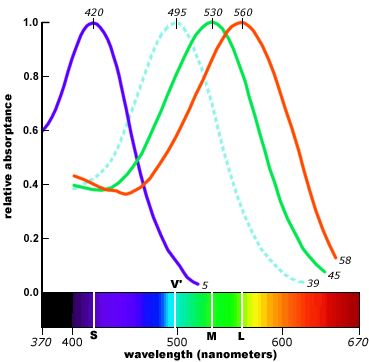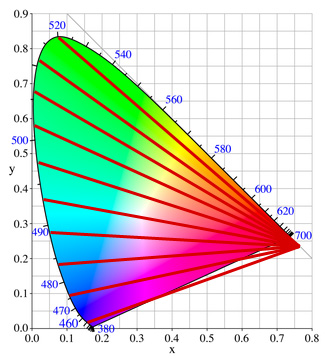In the first part of Color Blind Essentials we learned some fundamentals about color vision deficiency like the history, occurrences, causes, genetic inheritance patterns and more. With this second chapter I want to explain you the different types color blind people can suffer from.
But before we learn more about them we have to have a look at how color vision actually works. We have to do so because the functionality of the eye is closely related to the three main types of color blindness.
How color vision works
To see anything at all we need some tiny little helpers inside our eyeballs, the so called photorecptors. There are two different types of them: rods and cones. Both of them are sitting on the retina and pass information of light on to our brain. There are about 120 million rods which are very sensitive to light but not to color.

The cones are the photoreceptors which are responsible for our color vision. They are only about 6 to 7 million of them, gathering together very closely in the center of the retina, the so called fovea centralis.
And here comes the clue: Each of those cones is carrying one out of three different photopigments and therefore reacts differently on colored light sources. For each of this three types there exists a specific color absorption curve with peaks at different points in the color spectrum.
- S-cones: sensitive to short wavelength light with a peak at ca. 420nm (blue)
- M-cones: sensitive to medium wavelength light, peak at ca. 530nm (green)
- L-cones: sensitive to long wavelength light, peak at ca. 560nm (red)
Mixing together the information of those three different types of cones makes up our color vision. This is also the reason that only three main colors are needed if we want to mix together all visible colors, because we only have three sources of information for mixing our whole color spectrum.
Types of color vision deficiency
Based on this knowledge about our visual system we easily can put together the list of different forms of color blindness. All of them have a direct relation to the available photoreceptors in your eye and are accordingly categorized.
- Monochromatism: Either no cones available or just one type of them.
- Dichromatism: Only two different cone types, the third one is missing completely.
- Anomalous trichromatism: All three types but with shifted peaks of sensitivity for one of them. This results in a smaller color spectrum.
Dichromats and anomalous trichromats exist again in three different types according to the missing cone or in the latter case of its malfunctioning.
- Tritanopia/Tritanomaly: Missing/malfunctioning S-cone (blue).
- Deuteranopia/Deuteranomaly: Missing/malfunctioning M-cone (green).
- Protanopia/Protanomaly: Missing/malfunctioning L-cone (red).
For a better understanding you can also call them blue-, green-, or red-weakness respectively -blindness. Unfortunately this terms didn’t really made their way and are not used very often.
You could ask know: “What about red-green color blindness or blue-yellow color vision deficiency? These are the ones I know but I can’t find them in your lists above.”
That’s right. The problem with this well known terms is, that they are not telling the truth! Many people think that if you suffer from blue-yellow color blindness this are the only colors you can’t distinguish. But that’s wrong. Color blindness doesn’t relate to just two color hues you can’t distinguish, it is the whole color spectrum which is affected. More on this a little later in this article and in the next chapter of Color Blind Essentials where we will have a closer look at red-green color blindness.
But to solve the puzzle: blue-yellow color blindness relates to tritan defects and red-green color blindness to all types of protan or deutan defects.
| Type | Denomination | Prevalence | |
|---|---|---|---|
| Men | Women | ||
| Monochromacy | Achromatopsia | 0.00003% | |
| Dichromacy | Protanopia | 1.01% | 0.02% |
| Deuteranopia | 1.27% | 0.01% | |
| Tritanopia | 0.0001% | ||
| Anomalous Trichromacy |
Protanomaly | 1.08% | 0.03% |
| Deuteranomaly | 4.63% | 0.36% | |
| Tritanomaly | 0.0002% | ||
The above list shows you the prevalence rates of each type of color vision deficiency. The ratios between the most frequently occurring types for men can simply be remembered as: 1 protanope to 1 protanomalous trichromat to 1 deuteranope to 5 deteranomalous trichromats.
We already learned in the last chapter of Color Blind Essentials: What is color blindness?, that because of our genes more men than women are colorblind. Adding up all the numbers results in a total of 8% of men and 0.5% of women who are suffering from some type of color vision deficiency.
What do you see if you are colorblind?
We learned now a lot about the different types and categories of color vision deficiencies. But what does it really look like if you are colorblind? How do you see the world if you are colorblind? The four pictures below should give you a first impression.
 |
 |
| Normal Color Vision | Protanopia |
 |
 |
| Deuteranopia | Tritanopia |
If you have normal color vision you might realize that in the case of red-green color blindness (protanopia/deuteranopia) not only red and green colors are affected but the whole color spectrum is perceived differently. The same is of course true for blue-yellow color blindness (tritanopia). This is based on the fact, that all colors are perceived as a mixture of the three different cone types, and if one of them is missing the whole color spectrum changes.
The simulation below shows how the color spectrum changes. The shown lines are just meant as guides. Any line which ends in the so-called copunctal point connects the colors of confusion for a certain type of color vision deficiency. A more severe color blindness simply results in thicker and longer confusion bands.

Simply put you can say, color blind people see the world like people with normal color vision see it at dusk or dawn. At this time of the day colors start to fade away which is comparable to a color vision deficiency.
To learn more about how color vision works and to get a lot of interesting details about this topic, visit the excellent web site of Bruce MacEvoy on Color Vision.
In the next part of Color Blind Essentials we will have a closer look at the most common type of color vision deficiency: Red-Green Color Blindness.
